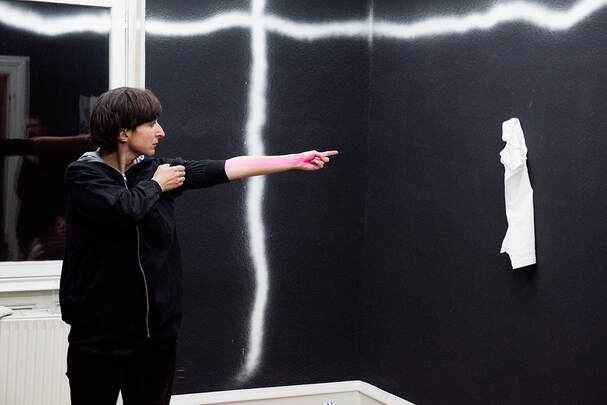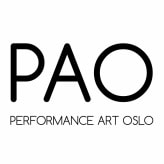Interview with Marita Bullmann
 Photo: Matthias Schleifer
Photo: Matthias Schleifer
Essen, Germany, 28.08.2019
Q: Why / when / how did you start to work with performance, what is your background, how did you arrive at doing performance?
I was dancing when I was a teenager. So, expressing myself with my body wasn’t new for me. I studied photography but had the chance to take part in classes in which I could work with video, body and installation.
During my studies in Israel at the Bezalel Academy of Art and Design I had visited performance art classes held by the performance artist Adina Bar-On. This experience led me deeper and deeper into the idea of working with performance as a medium and way of creating images. After returning to Germany I took part in some performance art workshops in which I explored many ways of approaching performance art. At that time, it was already really a big part of me, but I couldn’t really express it at my university, so all workshops and meetings were a big release and a way of deepening my understanding and my self-confidence in that field.
In the beginning of 2011 we founded the Action laboratory PAErsche. Since then I’ve been organizing, showing and promoting performance art in Essen where I’m based and also around the world.
Q: What is your process like when you make a performance, from idea to actual work?
It depends on the invitation, the place and my actual situation. Sometimes the idea and action forms itself when I see the space and feel the place and country. Sometimes I’m attracted by a certain material and like to show my sensation. Or I want to create a certain image that is in my head and then I look and choose materials in order to create it. That’s why there isn’t really a real structure to this process.
Q: Can you tell about your latest project?
My latest project was Interval °10 – my performance art platform that I organize in Essen and its neighboring cities.
Since 2013 INTERVAL offers a platform for international performance artists to meet and exchange ideas, strategies and concepts.
For this edition a total of ten local and international artists will be invited to explore the public space in the Ruhr area with all its multifaceted diversity and to develop and present site specific performative works and be part in the PAErsche Open Source Performance.
This edition was more focused on Performance Art which will expand the public places with processual, political and poetic images.
Q: What role does performance art have in your life / artistic praxis? Do you also work within other fields, like installation, sculpture, drawing, and other expressions? How do they influence / inform each other?
Yes. I do installations and work with photography. Some years ago, I strictly divided these parts but in the past two years they have grown more and more together, and I enjoy combining all these three fields.
I’m very happy about that in the book “Saudade”—which I published at Moinho Edições Limitadas in Brasil—images of my body, the landscape and text came together so concentrated for the first time.
Q: With what kind of form / material do you express yourself and use in your work and how did you arrive at using this material?
I use so many different materials, forms and sounds. It’s more the investigation and improvisation that let me create performances and installations.
I like to combine my actions and materials but for each invitation I do it differently and with a respect to the space and what’s possible.
But you will see that there is a certain obsession with water, pink and plastic things.
But this attention came naturally, and I didn’t choose it because of a certain reason.
Q: How do you experience or consider the audience / surrounding? What space / surrounding do you find interesting to work in? How does your surrounding influence your work? Do you involve the public? If so, how?
For me audience is important, otherwise I feel a bit stupid. Performance for just video or camera doesn’t work for me. I need the attention and concentration of the audience even if it’s just one or two people. I like to work in non-white cube situations like outdoors or private spaces like living rooms or very special locations like old houses or factories. All of these places have a certain dynamic and its singularities which give me ideas and I like to involve these in my performances. So, sometimes I just perform in front of the gallery because it’s much more interesting than just the white space.
I never involve audience in my performances, and I don’t like that much.
Q: Make your own question and answer it.
Is gender equality in art shows/festivals important for you?
I think we must pay attention and start questioning it when we see and detect inequality. Whenever I see a show or a program that basically show men positions, I speak up. For my own platform I try to be equal and if I must choose, I would always go for the women* position rather than men.
<< Back
